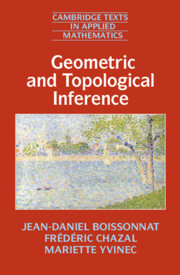Refine search
Actions for selected content:
48178 results in Computer Science
3 - Convex Polytopes
- from Part II - Delaunay Complexes
-
- Book:
- Geometric and Topological Inference
- Published online:
- 14 September 2018
- Print publication:
- 27 September 2018, pp 23-43
-
- Chapter
- Export citation
4 - Delaunay Complexes
- from Part II - Delaunay Complexes
-
- Book:
- Geometric and Topological Inference
- Published online:
- 14 September 2018
- Print publication:
- 27 September 2018, pp 44-68
-
- Chapter
- Export citation
ACTIVE REDUNDANCY ALLOCATION FOR COHERENT SYSTEMS WITH INDEPENDENT AND HETEROGENEOUS COMPONENTS
-
- Journal:
- Probability in the Engineering and Informational Sciences / Volume 34 / Issue 1 / January 2020
- Published online by Cambridge University Press:
- 26 September 2018, pp. 72-91
-
- Article
- Export citation

The Haskell School of Music
- From Signals to Symphonies
-
- Published online:
- 21 September 2018
- Print publication:
- 04 October 2018
MULTI-CLASS RESOURCE SHARING WITH BATCH ARRIVALS
-
- Journal:
- Probability in the Engineering and Informational Sciences / Volume 33 / Issue 3 / July 2019
- Published online by Cambridge University Press:
- 21 September 2018, pp. 348-366
-
- Article
- Export citation
COMPLIANCE AND COMMAND II, IMPERATIVES AND DEONTICS
-
- Journal:
- The Review of Symbolic Logic / Volume 11 / Issue 4 / December 2018
- Published online by Cambridge University Press:
- 21 September 2018, pp. 634-664
- Print publication:
- December 2018
-
- Article
- Export citation
A NEW STOPPING PROBLEM AND THE CRITICAL EXERCISE PRICE FOR AMERICAN FRACTIONAL LOOKBACK OPTION IN A SPECIAL MIXED JUMP-DIFFUSION MODEL
-
- Journal:
- Probability in the Engineering and Informational Sciences / Volume 34 / Issue 1 / January 2020
- Published online by Cambridge University Press:
- 21 September 2018, pp. 27-52
-
- Article
- Export citation
ROB volume 36 issue 11 Cover and Back matter
-
- Article
-
- You have access
- Export citation
ROB volume 36 issue 11 Cover and Front matter
-
- Article
-
- You have access
- Export citation
COMPLIANCE AND COMMAND I—CATEGORICAL IMPERATIVES
-
- Journal:
- The Review of Symbolic Logic / Volume 11 / Issue 4 / December 2018
- Published online by Cambridge University Press:
- 20 September 2018, pp. 609-633
- Print publication:
- December 2018
-
- Article
- Export citation
THE FRIENDSHIP PARADOX FOR WEIGHTED AND DIRECTED NETWORKS
- Part of
-
- Journal:
- Probability in the Engineering and Informational Sciences / Volume 33 / Issue 1 / January 2019
- Published online by Cambridge University Press:
- 18 September 2018, pp. 136-145
-
- Article
- Export citation
Leveraging human knowledge in tabular reinforcement learning: a study of human subjects
- Part of
-
- Journal:
- The Knowledge Engineering Review / Volume 33 / 2018
- Published online by Cambridge University Press:
- 17 September 2018, e14
-
- Article
- Export citation

Geometric and Topological Inference
-
- Published online:
- 14 September 2018
- Print publication:
- 27 September 2018
